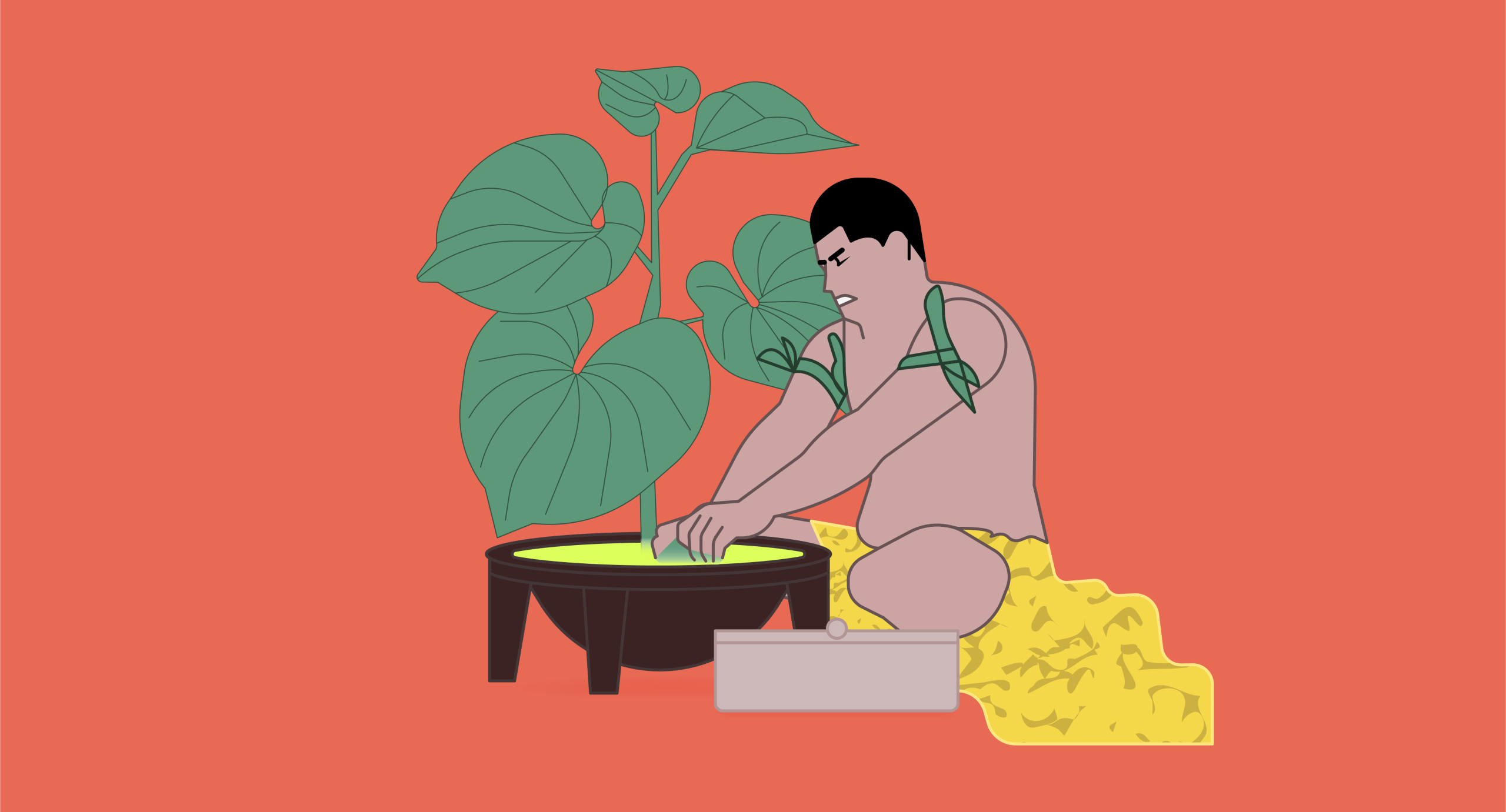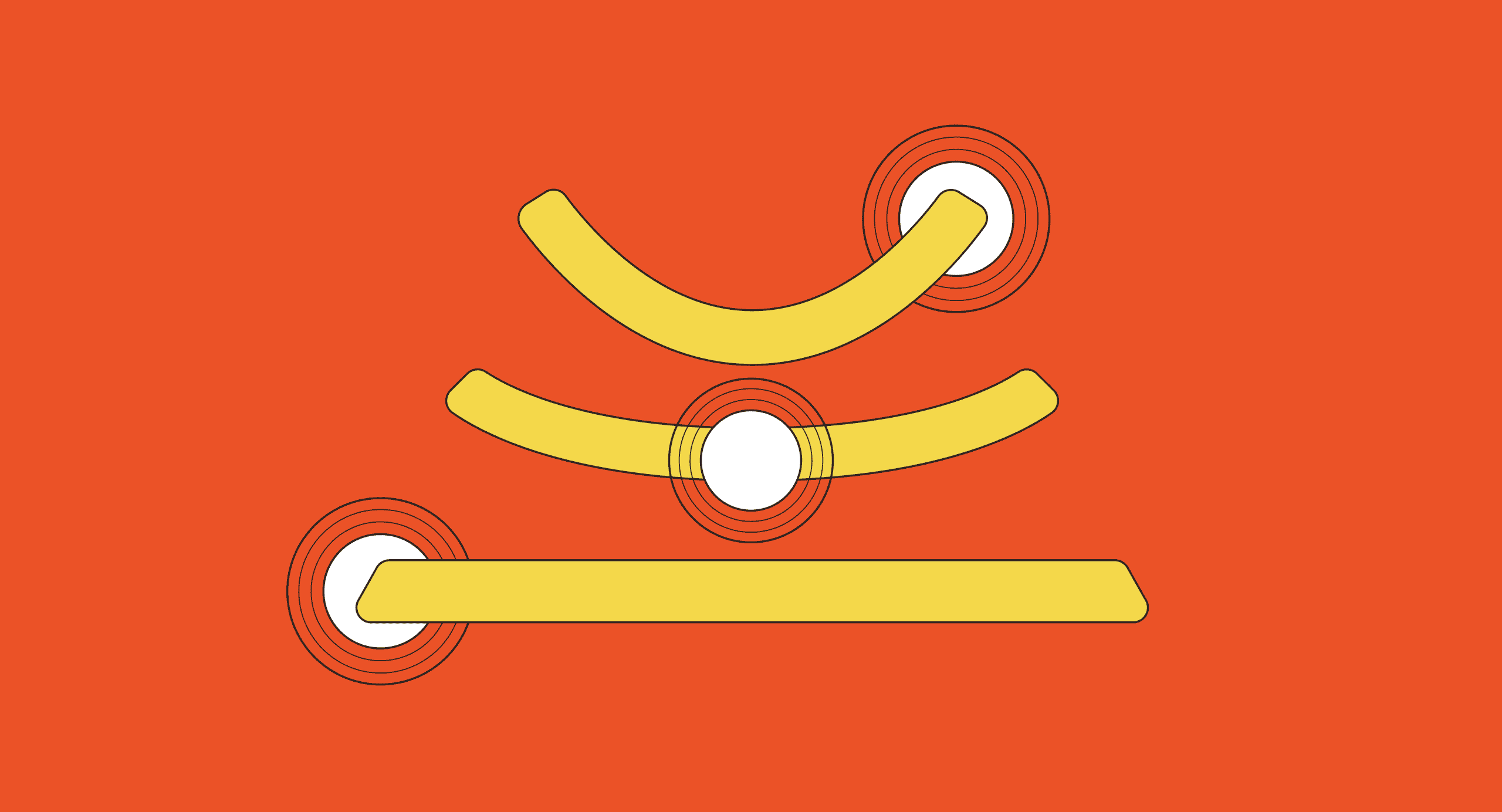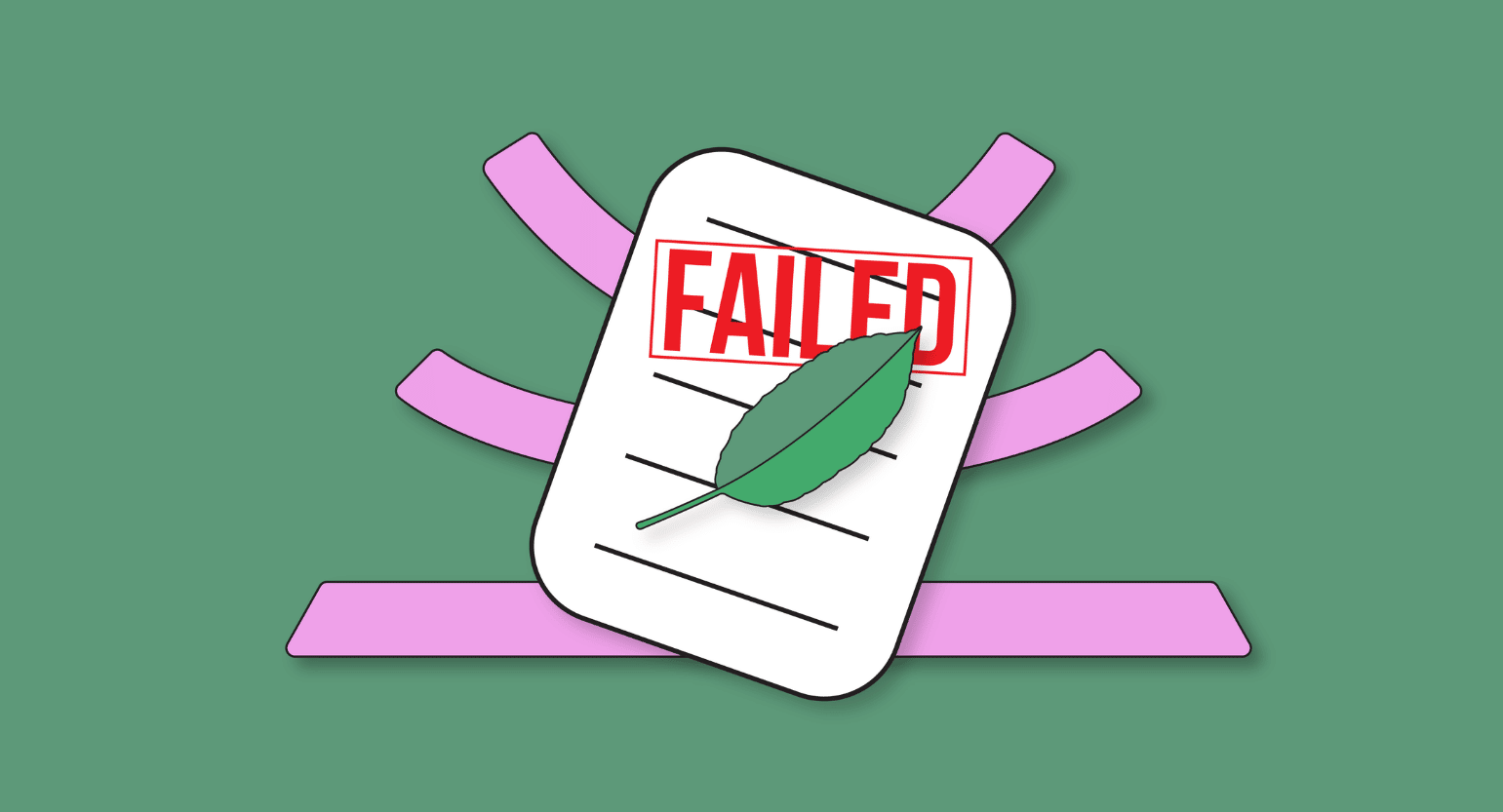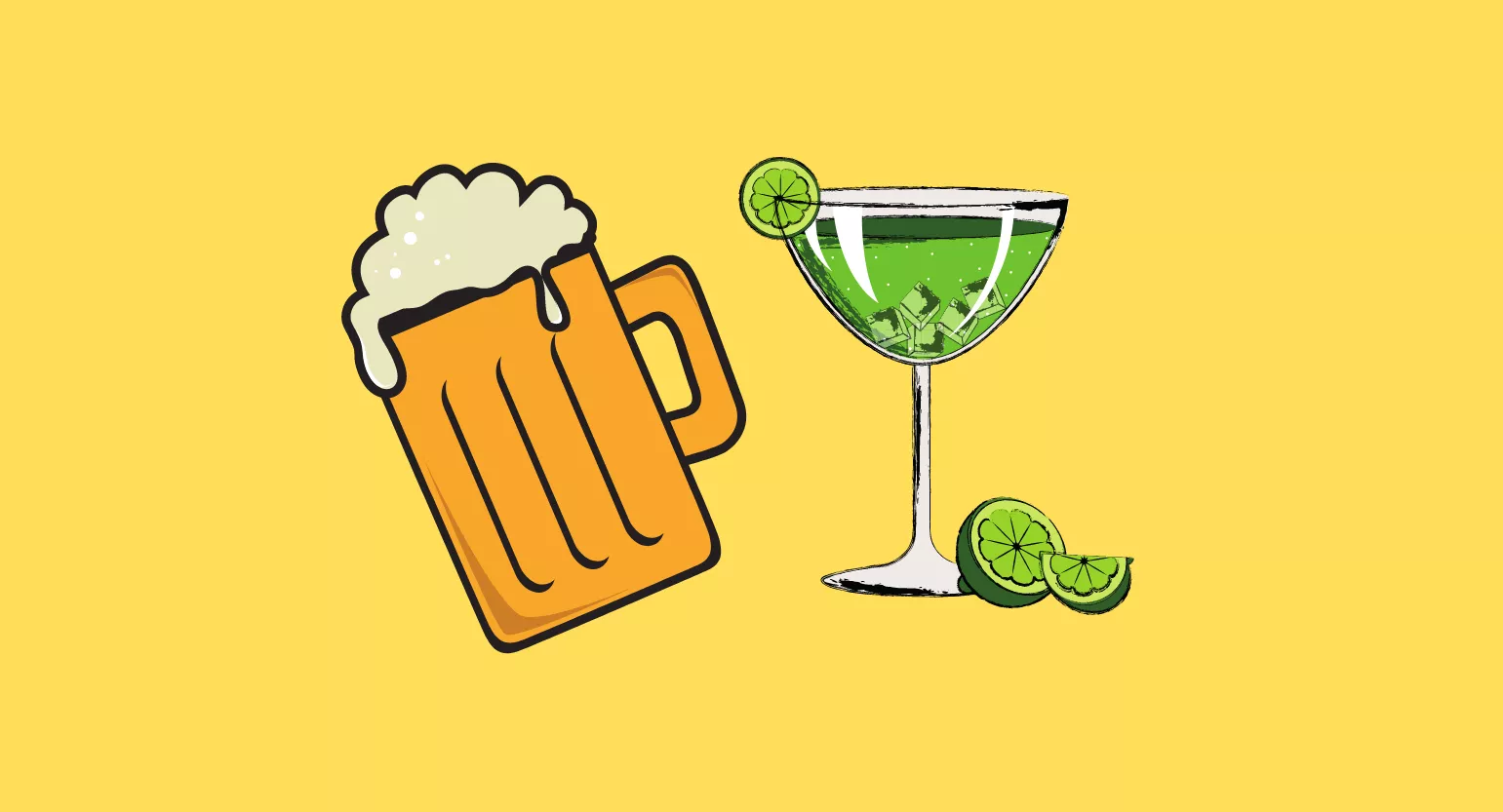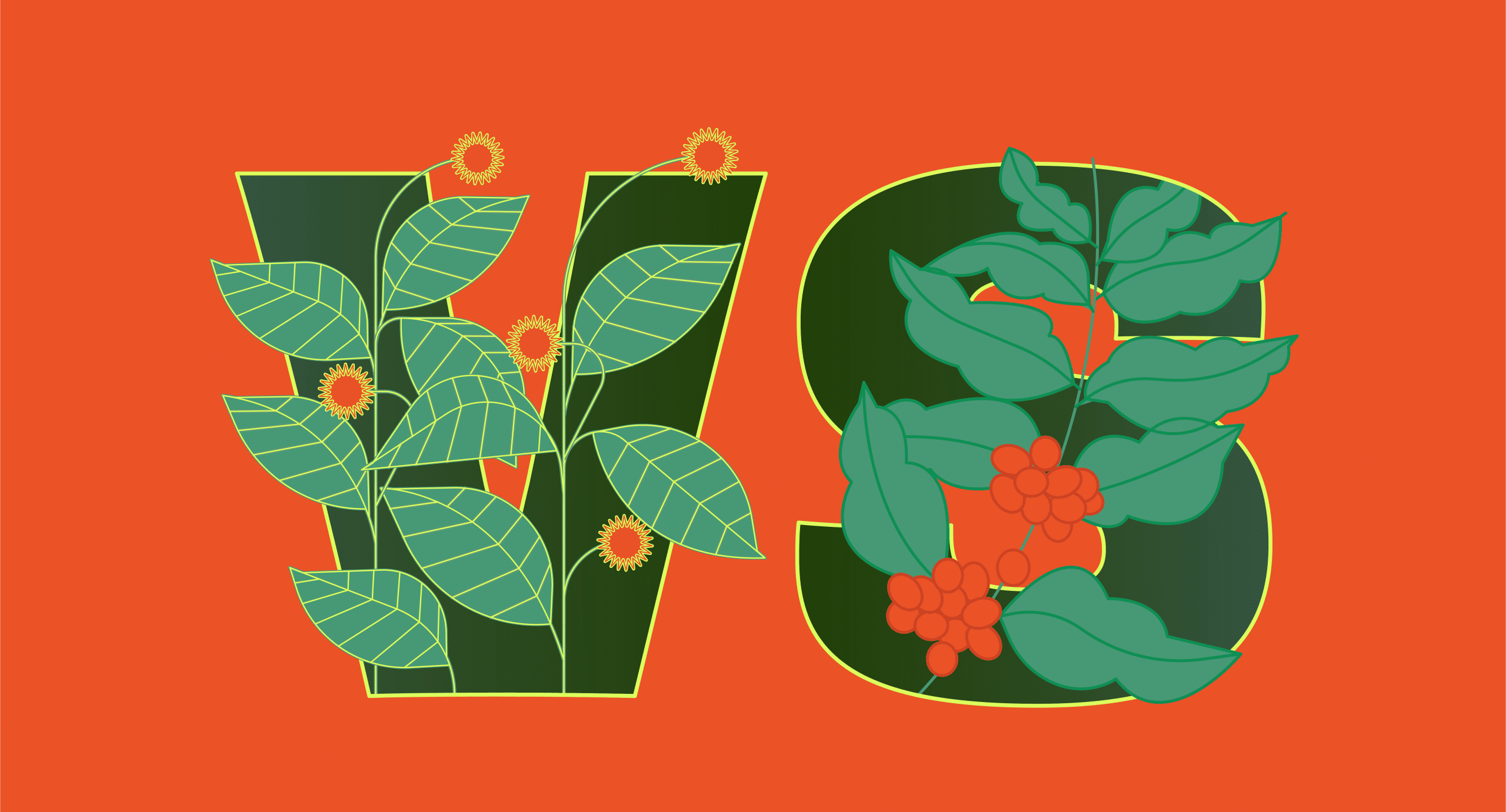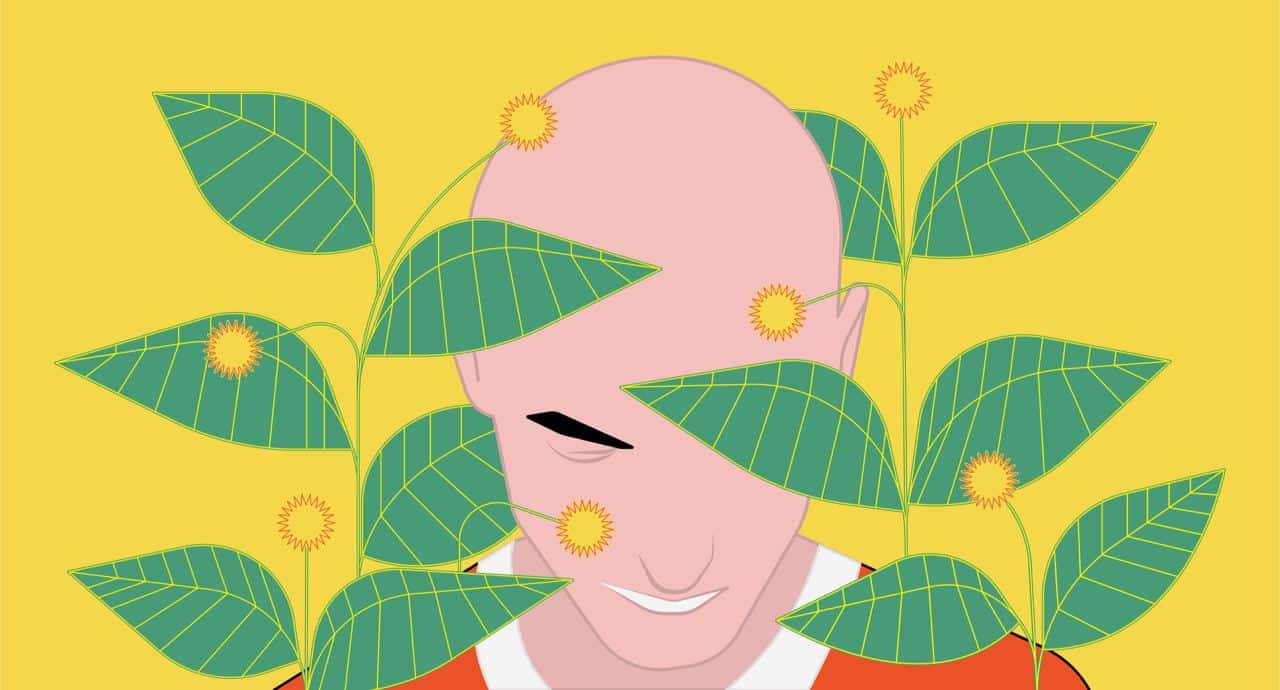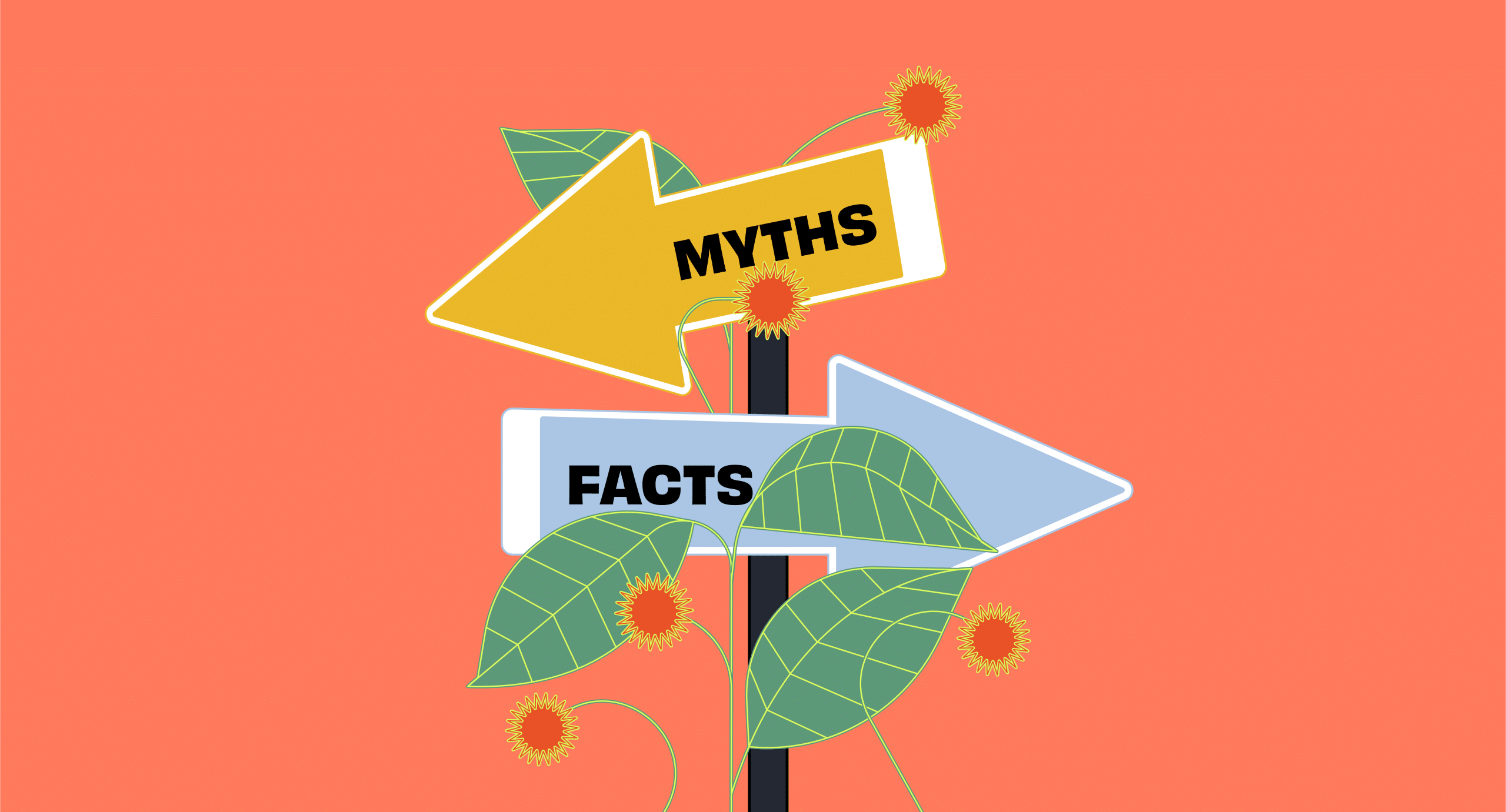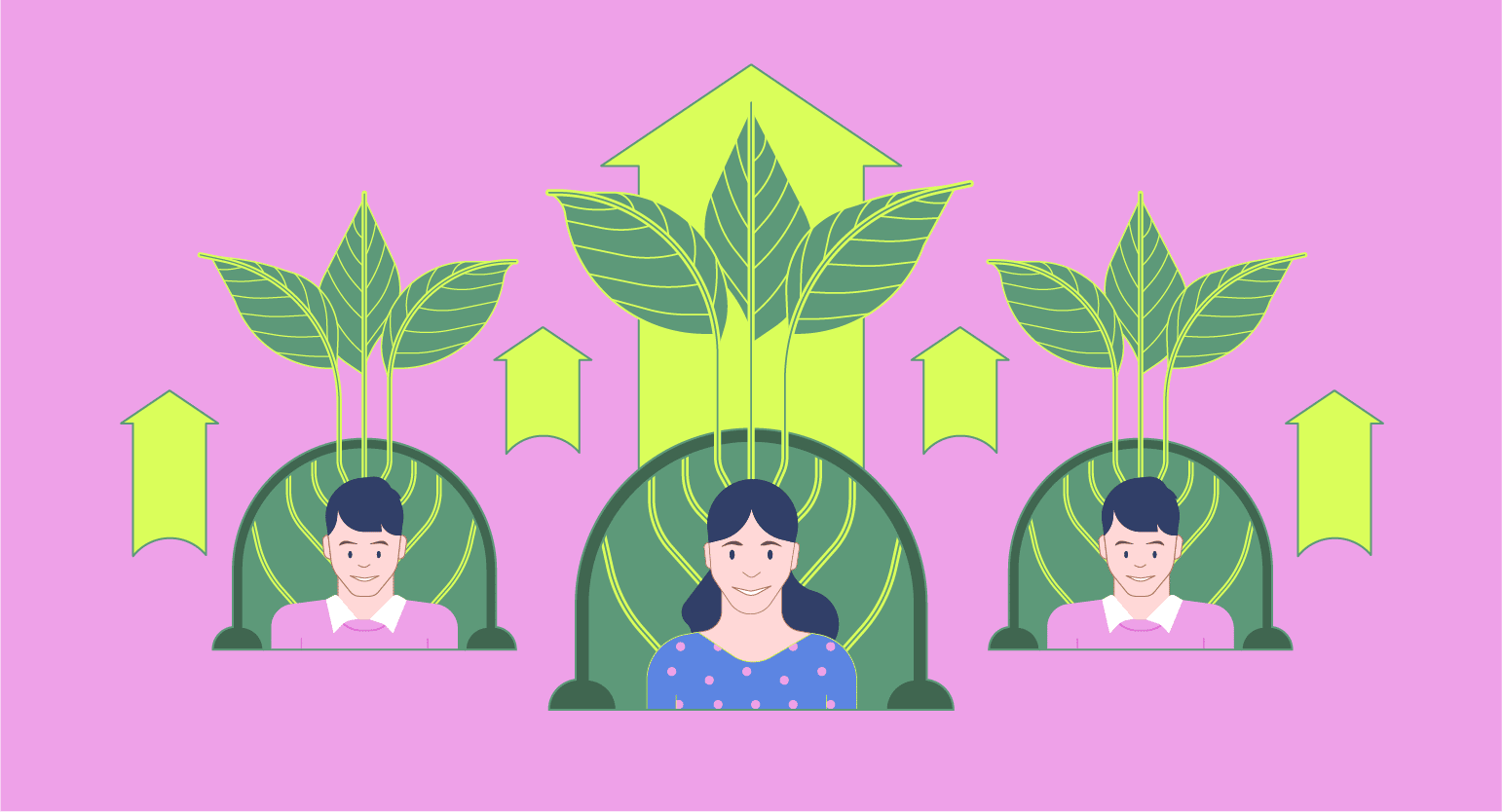P. Methysticum Taxonomy & Description
| Kingdom | Plantae |
| Subkingdom | Tracheophyta |
| Division | Angiosperm |
| Class | Magniolids |
| Order | Piperales |
| Family | Piperaceae |
| Genus | Piper |
| Species | P. methysticum |
Common names: Ava, awa, intoxicating long pepper
The plant’s official name, Piper methysticum, tells us a decent amount of its history. The Latinized Greek word for intoxication is methysticum; thus, kava is the intoxicating pepper. On the other hand, the word kava originates from the Tongan and Marquesan languages, which means ‘bitter’— certainly an apt description of kava [19].
P. methysticum is a perennial shrub that thrives in the South Pacific regions of Hawaii and Australia. Left untended, it can grow up to twenty feet tall, developing sets of nodular sections a lot like bamboo.

The leaves are bright green, cordate, and reach 5-10 inches long. The flowers are hardly conspicuous, perched atop pale yellowish spikes that arise from the ground. Stems are fleshy; the root has a distinct aroma and a bitter, pungent flavor and effect on the body when dried.
The flowers are sterile, so the plant is generally propagated by dividing the roots.
Pharmaceutical Actions
There are several pharmaceutical and herbal actions attributed to kava kava. These include: [20]
- Analgesic
- Anticonvulsant
- Anxiolytic
- Euphoriant
- Mild anesthetic
- Muscle relaxant
- Neuroprotective
- Sedative
Most of these effects seem to result from the fat-soluble compounds found within the root, called kavalactones.

A complete list of herbal actions can be difficult to find. Remember, not all of these uses are verified by science. Instead, they are based upon the herbalist’s rule of thumb, personal experience, or historical and anecdotal evidence.
- Anticonvulsive
- Antifungal
- Antipruritic
- Anxiolytic
- Hypnotic
- Local anesthetic
- Mild analgesic
- Mild analgesic (topical)
- Mild sedative
- Skeletal muscle relaxant
- Spasmolytic
Thus, kava would be indicated for the treatment of:
Nervous issues
- Anxiety and restlessness
- Headaches
- Insomnia or sleeping troubles
- Menopause
- Neuralgia/neurological pain
- Stress
- Tense muscles
- Withdrawal from GABAergic drugs like benzodiazepines or alcohol
Genito-urinary conditions
- Cystitis
- Dysuria
- Inflammation or infection of the urinary tract or genitals
- Renal colic
- Urethritis
Local conditions
- Sore throats
- Toothaches
Botanical Relations
Perhaps the closest and most often-confused botanical relationship that kava has is with a plant known by the Maori people as kawakawa (Piper excelsum). The confusion is evident in the name alone; however, the plants also look similar.
Nonetheless, the two plants are different species. The kawakawa tree is endemic to New Zealand and remains an essential component of Maori culture.
The Maori discovered the plant when they first explored southwards and landed in New Zealand. Much like the Polynesian explorers brought their kava to Hawaii, the Hawaiian travelers most likely brought kava south to New Zealand, only to find it too cold to cultivate.
The settlers, having lost their connection to their tribe’s sacred plant, thus gave the name kawakawa to P. excelsum to commemorate the kava plants that failed to propagate in New Zealand.
Kawa also has a unique meaning as a Maori word. It’s loosely translated as “ceremonial protocol,” bringing to mind the ceremonial and social aspects of kava consumption.
Kawakawa, however, is consumed exclusively medicinally. Like other Piper species, as you’ll see in the section below, its medicinal benefits are similar to other members of the genus. It’s a good herb for managing an upset stomach and speeding up wound healing or fighting infections.
Other Piper Species & Their Medicinal Similarities
As a member of the Piperaceae, or pepper family, kava has many close relatives used by traditional medicine practitioners and in fine cuisine. Black pepper (Piper nigrum) is, of course, one of the leading members of this family.
There are many other pepper plants and fruits, however. They are particularly popular in the Indian and Chinese systems of medicine, particularly regarding urinary, digestive, and painful conditions. Few are directly psychoactive, like kava, but all possess similar medicinal benefits [1].
Kava is also related to:
- Piper cubeba. The spicy fruits of this plant are used as a digestive aid to reduce gas, as well as a diuretic and an antiseptic for helping to quell urinary tract infections. In Chinese medicine, P. cubeba is called Pichengqie and possesses spicy, warming effects that can dispel spleen and kidney ailments (vomiting, hiccoughs, diarrhea). The fruit of P. cubeba is preferred to the root.
- Piper betel. This is one of the ingredients included in the mixture known as ‘betel chew,’ a stimulating mix made from the betel vine leaves (which is different from the highly stimulating betel nut.)
- Piper longum. This hot pepper is commonly traded from India to China. The Chinese use it as a digestive aid and an additive to prescriptions. The Chinese medical texts call P. longum ‘Bibu’ and acknowledge its spicy, hot effect on the stomach and large intestine. Its fruit combats gastric pain, vomiting, headaches, and toothaches.
- Piper retrofractum. This is popular in Indo-China and Thailand due to its ability to help fight fevers, liver disorders, and migraines.
- Piper hancei. This is referred to in the Chinese pharmacopeia as Haifengteng and is understood to be spicy and bitter, warming, and primarily affecting the liver and spleen. It helps manage rheumatism and joint conditions.
- Piper nigra. Also known as black pepper. It is called Hujiao in Chinese medicine. It’s spicy and hot, targets the stomach and large intestine, and the fruit helps to correct problems caused by too much phlegm or digestive disorders like cramping, nausea, and vomiting.
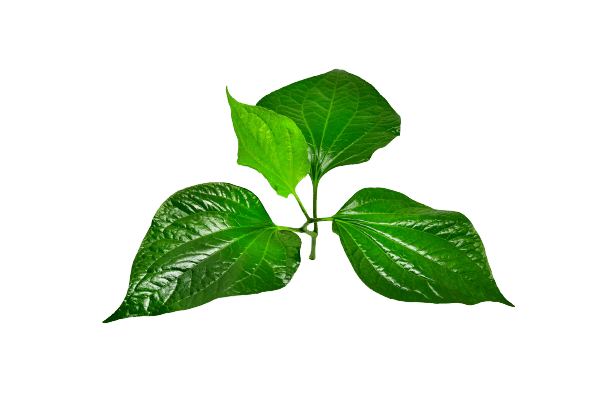
As you can see, the Piper species are no strangers to medicine. These are just a few of the plants in the genus.
P. methysticum, which grows as far north as the Hawaiian islands and as far south as Fiji, is not much different. Aside from its preference for volcanic soil, hence its preference for island regions, it possesses similar herbal actions.
These herbal actions (digestive enhancement, urinary protection, analgesia, etc.) are classic of the energetic qualities attributed to these plants. All of the plants in the pepper family are warm or hot, thus providing stimulation in the sense of increasing motion or activity in the body while reducing symptoms of cold, such as sluggish digestion.
The Chinese compendium likewise acknowledges kava to be spicy but not bitter. It acts as a hypnotic, narcotic, analgesic, urinary disinfectant, stomachic, and diaphoretic. It also works as a galactagogue and helps to induce labor.
The main difference between kava and its close relatives is the fact that less of its alkaloid content seems to favor the ability to improve digestion. Its sedative, anxiolytic, and analgesic properties dominate over all the others.
Kava would thus likely also affect the heart (due to how it influences dreams and drowsiness) and kidneys (since it can benefit water retention and inflammation in the urinary tract).
Alpinia spp.
Japanese and Taiwanese researchers recently discovered two alkaloids previously thought to exist only in P. mythestium in another plant, Alpinia speciosa. The alkaloids were proven effective for similar purposes as those isolated from kava [2].
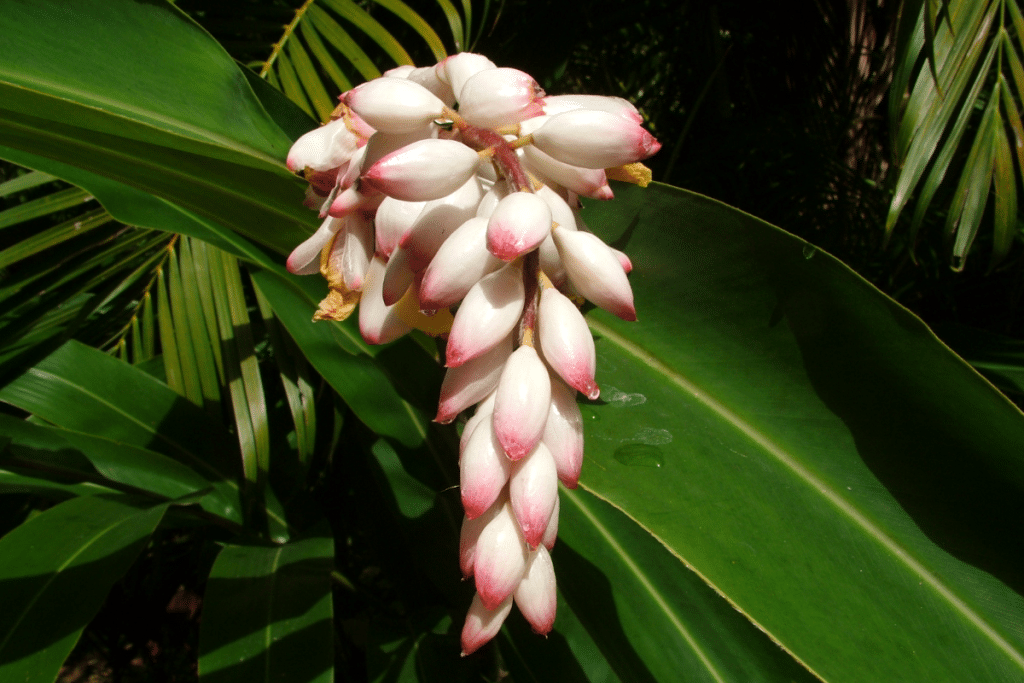
In this case, the researchers used them to test the effect of gastric acid inhibition. The alkaloids successfully inhibited secretions that various drugs would have increased. The alkaloids could also inhibit the symptoms of a histamine release for longer than five hours.
Researchers believe several other species of Alpinia may also contain kavalactones, which may need to be renamed if they continue to reveal themselves in other plants.
- Alpinia galanga, or Liangjiang. This rhizome is used in Chinese Medicine. It’s spicy and hot like all the other kavalactone-containing plants and has benefits for the stomach and spleen.
- Alpinia katsumadai. This plant is listed in the Chinese materia medica as Caodoukou; it is another spicy, warm herb that affects the spleen and stomach. It helps with pains in the gut and chest, reduces acidity and vomiting, and fights diarrhea.
- Alpinia oxyphylla. This is referred to as Yizhiren, a warm and spicy herb that Chinese medicine practitioners use to manage abdominal pain, vomiting, and diarrhea.
Interestingly, these plants all have similar health benefits and tastes compared to the Piper plants. The kavalactones themselves may impart spicy flavors.
A. speciosa, the first plant discussed, is sometimes used in Taiwan when cardamom is unavailable. Unsurprisingly, cardamom — another warm and spicy herb — has benefits that affect the digestive tract and the spleen.
History & Traditional Use
As far as psychoactive plants go, kava is first in popularity, historical use, and potency for plants that grow in the Pacific Islands. Popular as both a ceremonial and recreational/social herb, it has a prominent place in the culture of the various Hawaiian peoples.
Different cultures have their own methods of preparing the kava for consumption. Some prefer to pick the plant and let it dry, whereas others chew it fresh. Still, others like to pound the root and mix it with coconut fat.
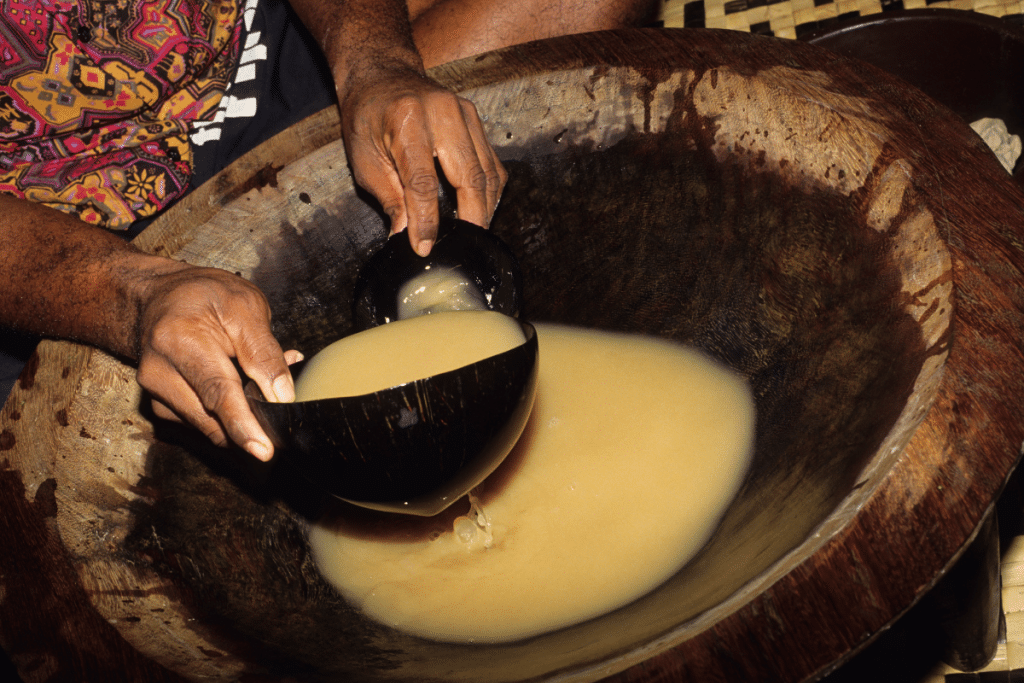
According to modern scientific research, this latter option would likely yield the strongest brew — especially if combined with some of the other methods.
This is because kavalactones are barely water-soluble. Thus why many people are disappointed when they try to brew a cup of kava tea and find themselves underwhelmed.
Some enzymes in human saliva bypass the lack of solubility by beginning to break down the kavalactones. Some Hawaiian tribes would have their young women chew and prepare kava for the elders. Pretty much all Hawaiian cultures chewed and shared their kava until the dirty and virus-laden Europeans arrived and announced it was unhygienic.
In modern times, kava has been banned in some countries. This is partly due to research that suggests that it may cause liver disease in rare cases. There is a low percentage of people affected by hepatotoxic effects.
Cultivation
Kava kava prefers to grow in loose, well-drained soil that allows oxygen to reach the roots. It grows in regions with plenty of annual rainfall, generally getting at least 78 inches of rain annually.
Its preferred temperature range is between 70-95℉ (21-35℃), and in a moist atmosphere, between 70-100% humidity. Since the plant is an understory crop (plants that like to grow in the shade), excessive sunlight can be destructive, especially when the plant is young [6].
Kava is an asexual plant and must be propagated by root cuttings. Female kava flowers are uncommon, and even when people pollinate them, they don’t bear any fruit [2].
Kava plants are usually allowed to grow for about four years. This allows a greater concentration of kavalactones to develop within the root structure. The plants generally don’t grow much taller than 6.5 feet (2 meters); their roots can grow up to 2 feet underground.
All of the kava plants in use nowadays were cloned from the wild ancestor of the kava plant, Piper wichmanii. There are hundreds of cultivars throughout the Pacific Islands, each of which has unique requirements for successful growth [3].
Each cultivar also possesses a unique alkaloid ratio and thus has a unique psychoactive effect.
Noble & Non-Noble Cultivars
Kava can be loosely divided into two categories: noble and non-noble cultivars. Non-noble kavas include a variety of different types: tudei kavas, those used for medicine, as well as wild kava (P. wichmanii, the original strain of kava from which modern cultivars were propagated).
Noble kavas are generally preferred for social usage or frequent drinking. They have a more psychoactive mix of alkaloids and a lower chance of causing undesirable side effects or lingering, hangover-like aftereffects.
Noble cultivars are the only ones that spread throughout the Pacific Islands, and this is likely the reason why. The non-noble cultivars are only found on the islands where they originated: Vanuatu.
There has been some controversy and debate regarding the use of tudei non-noble kava in products exported to Europe. Tudei kava, which belongs to the cultivars less psychoactive and more medicinally potent, is more likely to cause adverse reactions [4].
There is also some concern about importing non-noble cultivars to Fiji and Hawaii, where farmers are suspected of trying to grow the non-noble cultivars for export due to their quicker growing time. Whereas typical P. methysticum needs at least four years to mature, some other cultivars can be harvested within a year.
Unfortunately, these cultivars are inevitably less enjoyable due to their lower concentration of pleasant kavalactones. Additionally, they contain a separate set of alkaloids called flavokavins that may be dangerous to human health. These flavokavins are only present in minute quantities, if at all, in noble kava.
This has resulted in the development of legislation in regions like Vanuatu, with strict regulations regarding exporting such products. A Vanuatu kava producer must classify their kava as noble. Doing so requires that their product meets an exceptional standard: it must be farmed organically and have been growing for at least five years.
This and a global online education campaign to keep consumers up-to-date regarding the differences between noble and non-noble kava help ensure a quality kava supply. Any transparent website will let customers know upfront whether they’re buying noble or non-noble kava.
(Hint: if you’re checking out a website that doesn’t specify the type of kava, they’re probably trying to sell non-noble kava and slide under the radar.)
Parts of Kava Used
The roots are the main part of the plant used. The average plant yields around 110 pounds (50 kilograms) of roots upon harvesting.
The roots are separated into two types: crown roots and lateral roots. The crown roots are wide in diameter, look a bit like poker chips, and are known by the locals as chips. These roots comprise the majority of the harvest, roughly 80%.
The rest are lateral roots, much smaller in diameter and similar in shape to a regular root. The remaining 20% of these roots contain the richest density of kavalactones found in the entire plant. A particular type of kava made exclusively from the lateral roots is called Waka.
The higher up you look in the plant, the lower the concentration of kavalactones, suggesting that they prefer to develop in the dark. In the root, concentrations are roughly 15%, the stump 10%, and the basal stems around 5%.
However, modern herbalists have made extracts from all different parts of the plant. For some reason, extracts made from the leaf appear to be more active at the primary binding site of the kavalactones (GABA-A), as well as at the D2 dopamine receptor and several opioid receptors.
How Is Kava Used?
Look online, and you’ll see plenty of websites selling kava in different preparations. You’ll find bags of whole root, chopped root, tinctures, kava teas, capsules, powders, and even topical kava products. Where do you even start?
Kava Root
If you really want the best kava experience possible, you’ll need to go to an area where kava can grow abundantly. Then you’ll be able to try a drink made from fresh roots. Fresh roots, known as “green kava,” can be juiced right after harvesting and made into a powerful drink.
Most of the roots, however, are dried. This allows them to be stored for much longer and prepares them for export. Many of these roots are powdered before being exported. Both of these processes can somewhat degrade the quality of the kava, but there are plenty of strong products to be had overseas.
Kava Tea
Well, the first place not to start is with kava teas. Or perhaps it’s better to say that somebody interested in the mildest experience that could possibly result from kava may want to try the tea.
Remember, the kavalactones present in the plant aren’t very soluble in water. The only way you can efficiently extract them into tea is if you simmer or at least steep them in cream or milk, or some other fatty substance, before starting.
Simply simmering kava in water for 15 minutes and then drinking may provide a subtle experience, but you’re still wasting about 80% of the potency of the kavalactones.
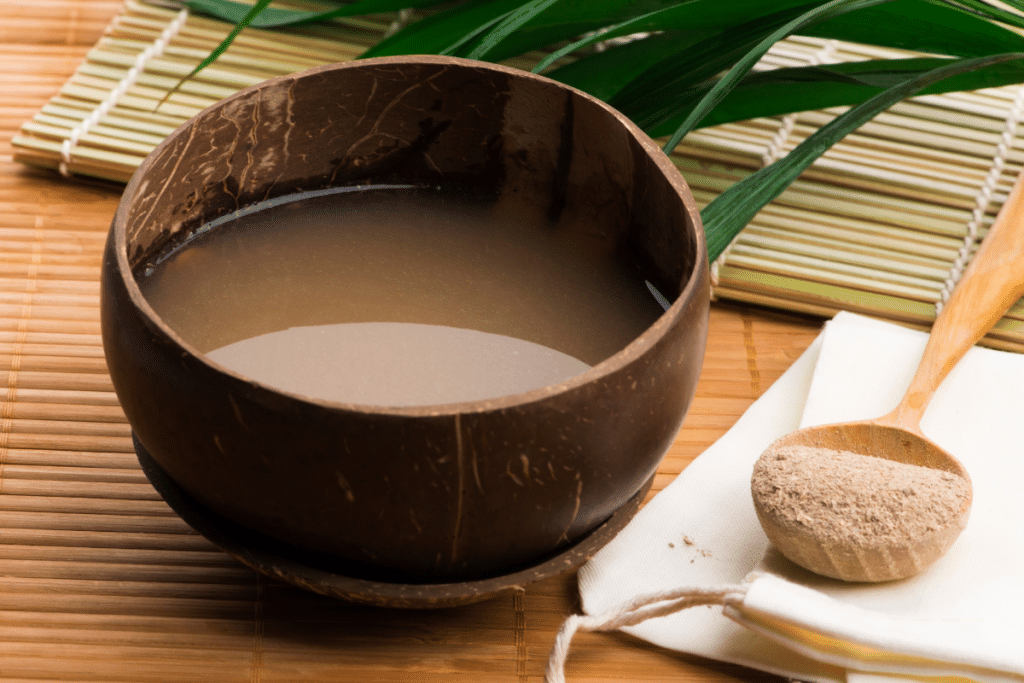
Nonetheless, certain brands of kava tea do seem to have positive reviews online. However, these positive reports are invariably countered by users familiar with chewing fresh kava root, whose retorts ring along the lines of “wait until you try the whole root.”
Kava Powder
Kava powder is often one of the cheaper ways to get a large amount of kava. Unfortunately, most people are unsure what to do with kava powder to get effective results. Again, many of the only recipes will only provide you with a subpar experience.
Kava powder is relatively versatile, though, and there is quite a bit that you can do with it. One would be forgiven for wanting to drink kava tea for simplicity’s sake alone.
Some sites suggest making tea with it. If you choose to do that, take the advice from the previous section and make sure to simmer it first in oil or cream.
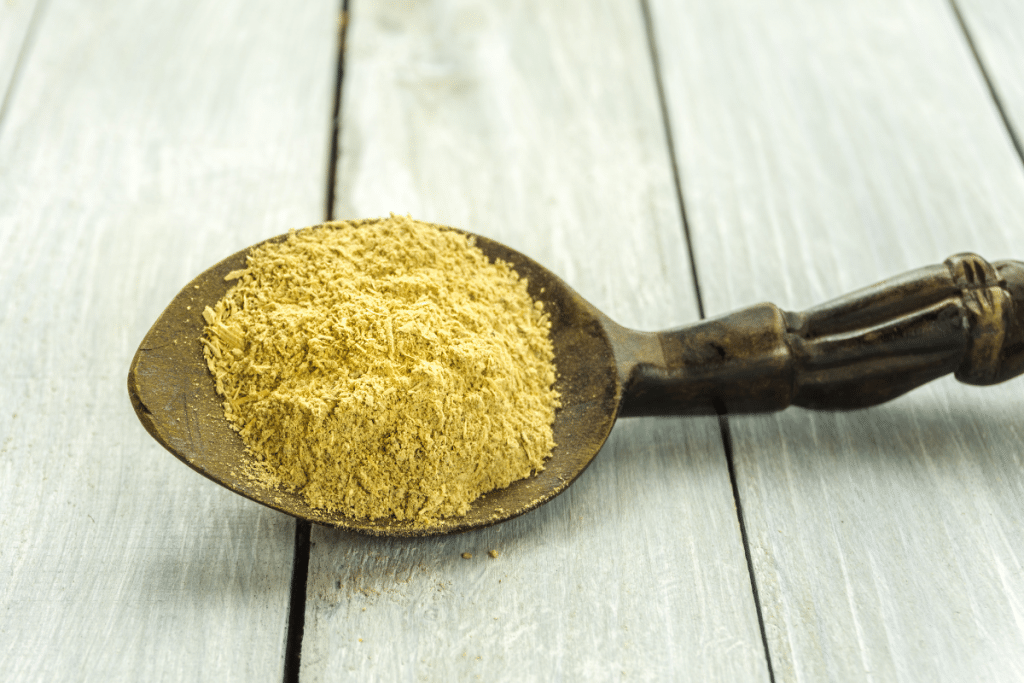
Another way to take the powder is sublingual. Simply place a half-teaspoon or teaspoon of kava under your tongue and hold it there as long as possible. You should notice that your mouth starts to go numb.
Keep holding it. The numbness indicates that the enzymes in your saliva are extracting the kavalactones. To speed up the process, add a small amount of cream or oil to the mixture to help pull the alkaloids faster.
Some people say that a minute or two is enough time. Realistically though, whatever you’re swallowing is a waste. It’s best to keep the kava under your tongue until there’s nothing left so as much as possible can be absorbed directly into your blood.
Another way to extract kavalactones is to knead the powder. You can wrap the kava in a cloth or piece of fabric and put it in a bowl, soak it through with hot water and preferably a source of fat, and squeeze and knead until you think there couldn’t possibly be any kavalactones left.
Micronized Kava Powder
Micronized kava powders are designed for busy people who don’t have the time to knead their kava whenever they want to make a drink. It tastes a bit better than regular powder as well.
Just as with other products, there is some variation in potency to be expected from vendor to vendor. If you’re buying micronized powder, make sure you note whether you’re buying whole root micronized powder or powder with coarse fibers or makas removed.
If you’re buying a product with the coarse fibers removed, you will get a much more robust product as these plant parts don’t contain kavalactones.
Kava Tinctures & Capsules
Kava tinctures and capsules are two of the weakest forms of kava. However, they’re also a simple way to consume the plant without having to do any additional grunt work. Just make sure to check the bottle to see that they’re made to a standardized amount of kavalactones.
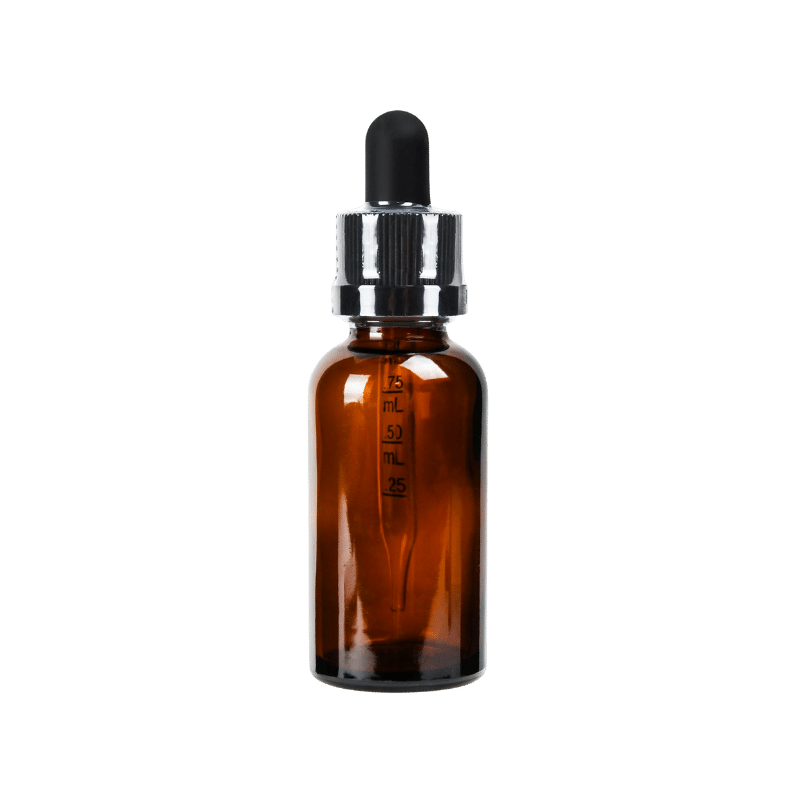
Kava Pastes
Kava pastes are not very common, and with good reason. They’re expensive to make, and they’re incredibly strong.
Kava pastes are generally made with CO2 extractions. They can yield products that have a whopping 60-85% concentration of kavalactones. Use these products extremely carefully as they’re orders of magnitude stronger than anything else.
You also want to ensure that your vendor acknowledges using noble kava for their CO2 extracts. If you have to contact them about this, don’t hesitate because if they’re not transparent on their website, they may be trying to sell you a shoddy product.
Varieties & Cultivars of Kava
There are many different cultivars of kava. So many, in fact, that it’d be impossible to list them all in this article. Fortunately, they break down into several categories that make for easier classification.
Noble & Tudei Kava
As we discussed earlier, noble and tudei kava cultivars are the main distinction between kava plants. Noble plants provide kava for casual usage, whereas tudei kava is less beneficial for everyday or frequent ceremonial use.
Heady & Heavy Kava
Kava cultivars are also divided into different categories based on their effects. Heady and heavy kavas are two of the most apparent distinctions, although connoisseurs may delve into further subclassifications.
- Heady kavas are primarily used for enhancing mood, reducing anxiety, increasing sociability, and putting you in a better headspace. Heady kavas are great for social gatherings and are often fairly stimulating due to the higher concentration of yapoinin.
- Heavy kavas are the opposite of heady ones and are great for people who prefer to have an experience that’s much more physically apparent. Heavy kava produces strong sensations of relaxation and sedation and should be used when you don’t have any responsibilities for the rest of the day or the next morning.
- Balanced kavas are the best for all-purpose usage. They’re not as sedating as heavy kava but can still provide a mood boost and act as a social lubricant.
Active Constituents & Alkaloids in Kava
Most of the fresh kava root is water, so most kava for medicinal or ceremonial purposes is dried first. This leads to a loss of about 80% of its weight.
The dry weight comprises carbohydrates (about 40% starch, 20% fiber, and ~3% sugar). The plant usually manages to retain about 12% of its moisture. Vitamins, minerals, and other nutrients make up about 10.5% of the root.
- Amino acids. At least 15 have been identified in kava.
- Minerals. These include aluminum, iron, magnesium, potassium, calcium, and sodium.
- Chalcones. These are natural phenols related to chalcone that form the central core of numerous biological compounds and often possess antimicrobial and anti-inflammatory properties. Kava contains at least three: flavokavins A, B, and C [5].
- Cinnamic acid. This is the precursor to aspartame.
That would leave about 14.5% left for the presence of active constituents, although really, the amount can range from 3 to 20% of the root. These compounds are pyrone derivatives, some of which are quite complex and referred to as lactones, or more specifically, kavalactones.
Kavalactones
The various actions of kava kava are largely the result of the lipophilic (fat-soluble) alkaloids called kavalactones. Products with a high concentration of kavalactones are considered desirable in the modern kava supplement market.
Of these, kavain is the base substance likely metabolized into some of the other kavalactones.
Several different kavalactones have been identified, about 18 in total, with about 96% of their total biodynamic action resulting from just six of them.
The six bioactive kavalactones include [7]:
- Desmethoxyyangonin
- Dihydrokavain (or dihydrokavain)
- Dihydromethysticin
- Kavain (also known as kawain), which contains an alpha pyrone
- Methysticin
- Yangonin, which contains a gamma pyrone ring
Researchers have also detected derivatives of yangonin in the plant, such as dihydroyangonin and desmethoxyyangonin. Dihydrokava-acid, a saturated derivative of the base kavalactone, kavain, has also been identified with a broken pyrene ring.
Kavaic Acid
Kavaic acid is perhaps the most obvious of the kavalactones: it’s the one that produces a sensation of numbness when chewed. This is also the alkaloid that produces topical analgesia. This action is very similar to cocaine; kavaic acid has similar potential as a local anesthetic in the same ways.
In fact, traditional Fijians would chew kava during tattoo ceremonies. To manage the pain, they would chew large doses of kava and then apply it topically to the tattoo site.
Dihydrokavain
The root produces dihydrokavain as it dries and ages. Roots from new plants often contain as little as 0.2% of this alkaloid, whereas a root left to dry for a year contains up to five times more (1% total dry weight), and some roots dried for several years can produce up to 3%.
This may result from a reverse-oxidation process that occurs with the kavain. The breakdown of certain alkaloids and their metabolism into other ones is common among plants of all different types.
Dihydrokavain is certainly one of the more sedating kavalactones. When administered to mice in studies, it put them to sleep within 20 minutes. The lack of toxicity was also proven in a study where the rats were given ridiculous doses of 50-200 mg/kg — the human equivalent of chewing 2-8 pounds (1-4 kilograms) of the root — without any negative effects.
Due to the lack of solubility in water, this alkaloid is best absorbed when consumed as a powder alongside a fatty food, extracted in vegetable oils, or extensively chewing the root.
Similarities Among Piper Species & Their Medicinal Components
As mentioned above, kava has numerous botanical relations that provide similar health benefits. We have addressed these similarities in terms of herbal energetics but less so in terms of medicinal compounds and alkaloid content.
Methysticin is one of the main kavalactones present in P. methysticum. It contains within its chemical structure safrole, a compound first isolated from sassafras. In the kavalactone, safrole is attached to the base kava pyrone ring.
Much like one experiences when chewing kava root, safrole is also known to cause a numbing sensation. It also shares other properties with kava: it’s an anodyne, a diaphoretic, a stimulant, and a diaphoretic, the main difference being that sassafrass is not nearly as sedating.
Safrole is in numerous warm and spicy Chinese herbs, such as camphor root (Zhangnao), illicium (Tahuisiang), fennel (Xiaohuixiang), and nutmeg (Roudoukou). All of these herbs affect the digestive tract or the respiratory system.
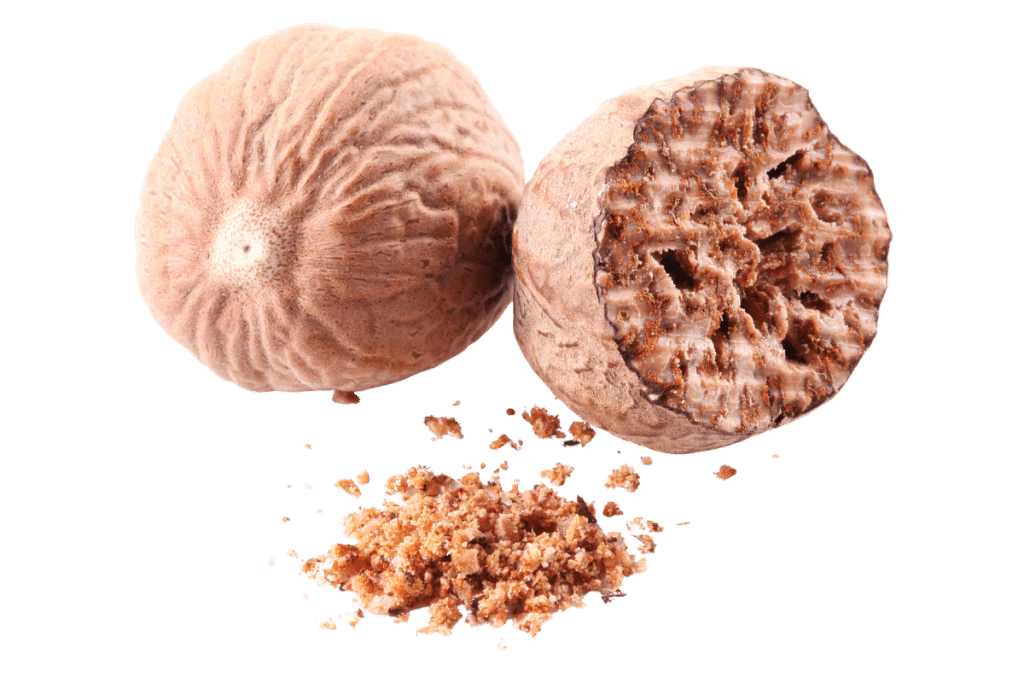
The base structure of methysticin is found elsewhere in the Piper family, such as piperine, the chief compound derived from black pepper. It’s also in chavicine, another alkaloid found in numerous Piper species.
Similar compounds throughout the Piper species include piperlongumine, methyl piperate, and futoamide.
Kavain is chemically bonded to a compound structurally similar to cinnamic acid, a spicy, bitter substance that has potent effects on the spleen, digestion, heart, and respiratory system.
Yangoin and dihydroyangonin have a kava pyrone bound to a moiety of the estragole type. Estragole is another hot and spicy compound found in various Chinese herbs:
- Agastache, or Huoxiang, targets the spleen, stomach, and respiratory system.
- Magnolia bark, or Houpo, is a herb used to help the spleen, stomach, intestines, and lungs.
- Frankincense, or Ruxiang, is a warm and spicy resin used in Chinese and Indian medicine to help the spleen and digestion and acts as an analgesic.
- Basil, or Luole, is used to prevent spasms and diseases of the kidney and digestion.
The Compound or the Content?
Due to all of the above comparisons between different compounds found in the various families of hot and spicy herbs, the compounds themselves may not be the most critical component.
Instead, it is the compounds attached to the pyrone rings within the structure of the kavalactones (or, indeed, the alkaloids of other Piper spp. or Alpinia spp., which contain the core compounds attached to the pyrone rings but not the pyrone rings themselves).
A synthetic study proved this to be true. Taiwanese researchers created synthetic kawain pyrone rings without attaching anything to them and evaluated their effects on ulcers. The response was minimal, at best, when the pyrone was tested alone. When attached to a hexanyl group, however, the results were highly effective [8].
Pharmacology of Kava
Kava has very interesting and unique pharmacology.
All of the pyrone kavalactones act on the spinal cord of human beings, thus exerting influence on the central nervous system. In most cases, they do so by relaxing the skeletal muscles and relaxing reflex irritability.
On top of this, they function as local anesthetics and antipyretics, possibly due to their ability to improve blood flow through the dilation of blood vessels.
Its primary mechanism is stimulating the GABA system in the brain and nervous system. GABA is an inhibitory neurotransmitter that serves to regulate glutamate excitation [9].
Glutamate is another neurotransmitter. As an excitatory neurotransmitter, it helps cells in your nervous system fire and send messages to one another. Excessive neural firing can lead to issues like anxiety and jittering; releasing some GABA can counteract this.
Kava also inhibits the reuptake of norepinephrine through its influence on GABA. Norepinephrine (or noradrenaline) is a stimulating neurotransmitter that promotes the fight-or-flight response. This is also marked by overexcitation of the nervous system (aka anxiety). Thus kava excels at promoting relaxation and counteracting overstimulation.

Because kava is not well absorbed in the stomach, people prefer to absorb it sublingually. This is part of the reason that traditional peoples would chew the root and spit it into a communal dish as a method of consumption.
There are trace amounts of lipids in saliva, in addition to the enzymes that help break down and facilitate the absorption of kava. Once the saliva had begun to break down the raw plant material and extract the kavalactones, it could be effectively drunk.
The kavalactones’ effect is interesting because they create an effect greater than the sum of their parts.
Pharmacological Mechanisms
Individually, these kavalactones remain active. However, when combined (i.e., when taken as nature intended by consuming the whole root), they synergize to produce a significantly more potent effect.
Some of these kavalactones might potentiate the pathways by which other kavalactones make their way into the brain or disinhibit the degradation of other kavalactones. Thus the presence of multiple kavalactones will enhance the overall experience.
The kavalactones primarily act upon the limbic system [10].
There are a lot of different suggested pathways by which kavalactones may exhibit their effects.
- Blockade of voltage-gated sodium ion channels [11]
- Reducing the excitatory neurotransmitters, such as glutamate, by inhibiting calcium channel ions
- Binding to receptors in the endocannabinoid system, especially the CB1 receptor (the same one THC binds to) [13]
- Enhancing the ability of endogenous ligands to bind to the GABA system
- Inhibiting monoamine oxidase, the enzyme which breaks down neurotransmitters and thus reduces their effects (also known as MAOI)
- Reducing the reuptake of norepinephrine and dopamine [14]
- Preventing the brain from synthesizing thromboxane A2, a compound that antagonizes receptors in the GABA system.
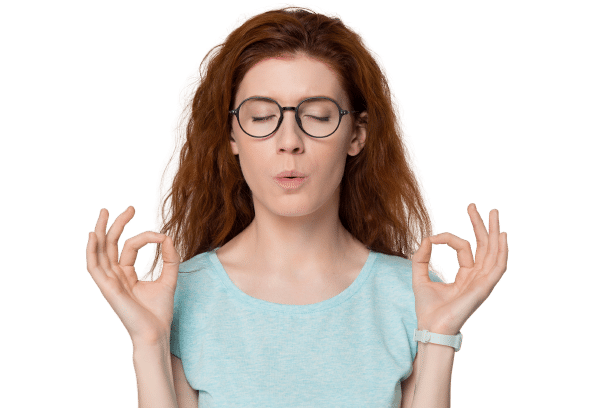
The anxiolytic and relaxing properties of kava are almost certainly related to its influence on the GABA system. Two kavalactones, kavain and dihydrokavain, seem most effective at producing anxiolysis [14].
Interestingly and importantly, they seem to be able to do this in a manner nearly as effective as conventional GABAergic drugs like benzodiazepines. However, they do so without causing users to lose their sense of mental acuity.
Kava Tolerance & Reverse Tolerance
There’s a lot of discussion regarding the development of tolerance in kava users.
Some hold that the plant exhibits a complete reverse tolerance, becoming stronger as you use it. Others believe it causes tolerance in a typical manner, causing people to need larger and larger doses to enjoy the same effect.
Regardless, it’s a relief to note that kava isn’t physically addictive and won’t lead to dependence, another point in favor of reverse tolerance!
Many people experience regular chronic tolerance when consuming kava. Just as with other psychoactive compounds, they’ll find that they need to take regular breaks in their consumption; otherwise, the effects just won’t feel the same.
But many people also experience different degrees of reverse tolerance.
Some people don’t feel the effects of the plant at all their first time using it. Some people don’t feel anything for a couple of weeks, even if they use kava daily. In rare cases, some people never feel it, but this is a sort of natural immunity, not really a tolerance.
Is Reverse Tolerance Dangerous?
Everyone who experiences reverse tolerance will experience it differently. Individual body chemistry, metabolism, and other factors contribute to how long it takes to break through and whether or not you’ll experience the effects.
For some people, once they’ve broken through the initial period of feeling nothing, they’ll gradually begin to experience a stronger buzz each time they use kava.
This might sound dangerous at first, but luckily, you can’t really overdose on kava. As such, people with a reverse tolerance eventually run into some sort of ceiling effect where they can’t experience the effects any more intensely.
Once they reach this threshold, the effects either plateau (if the kava is stimulating) or cause lethargy (if the kava is sedating).
People can often use large amounts of kava for extended periods without experiencing withdrawal. Sometimes, but not always.
Some people experience typical GABAergic withdrawal symptoms when suddenly stopping a very heavy kava habit, although this is not nearly as dangerous as withdrawal from other GABAergics like alcohol.
However, those who experience a reverse tolerance may upregulate specific neurotransmitter systems, leading to long-lasting health benefits that persist after stopping kava.
Instead of experiencing an uncomfortable return to baseline accompanied by downregulated and semi-functional neurotransmitter systems, the individual would slowly come down towards baseline from an elevated high resulting from kava, making your neurotransmitters hyper-effective.
Scientific Evidence for Benefits of Kava Kava
Kava kava has been the subject of numerous studies, mostly due to its potent ability to fight anxiety.
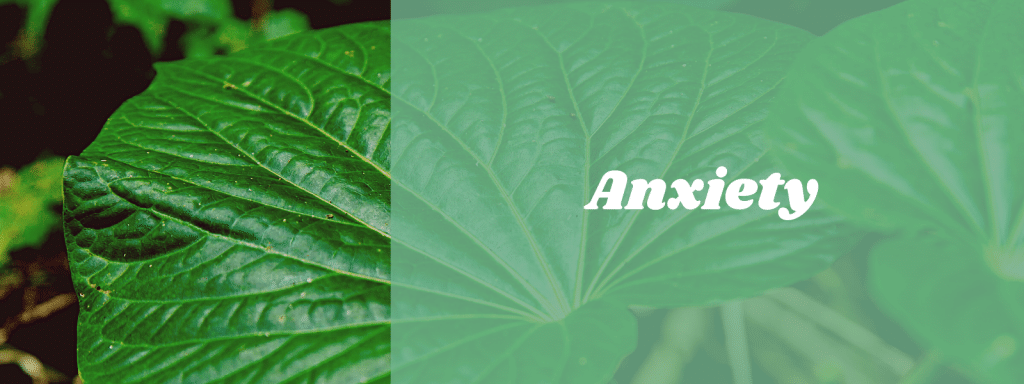
Kava for Anxiety
Many studies prove kava to be an excellent anxiolytic, consistently and significantly more effective than a placebo for managing general anxiety disorder.
Several benefits make its use appealing compared to other anxiety-relieving drugs [16].
- It’s unlikely to cause addiction.
- It helps reduce anxiety without blunting cognition or emotion and can even enhance cognition.
- Negative side effects are almost entirely absent from kava
- Kava lacks many of the sedative-hypnotic effects that are common with other anxiolytics
Here are some more details regarding the use of kava kava in scientific studies.
One study evaluated the use of kava over the long term and noted impressive results. The study, which involved patients who all scored 19 or higher on the Hamilton Anxiety Scale, were randomized into two groups and given either a placebo or an extract of kava containing at least 70% kavalactones (the particular extract is branded WS 1490) [17].
Those using the extract showed a significant improvement after the initial evaluation period of 8 weeks, which only continued to increase as the study progressed to 12, 20, and eventually 24 weeks.
Patients did not develop significant issues with tolerance to the supplement, nor were adverse effects common. A few adverse effects did occur in equal amounts in both the placebo and kava groups.
Dozens of other studies on kava kava show similar results. It seems that most of these studies use the same WS 1490 standardized extract, thus allowing for consistency between studies.
Another study aimed to evaluate the usefulness of kava kava for helping to balance out the emotional health of perimenopausal women [20]. The women were given either a placebo, a gram capsule of calcium, 100 mg of kava, or 200 mg of kava.
Reductions in anxiety were observed by the end of the first month and continued to decrease until they were measured again during the third month. Self-reported scores reflecting depression also decreased after the third month.
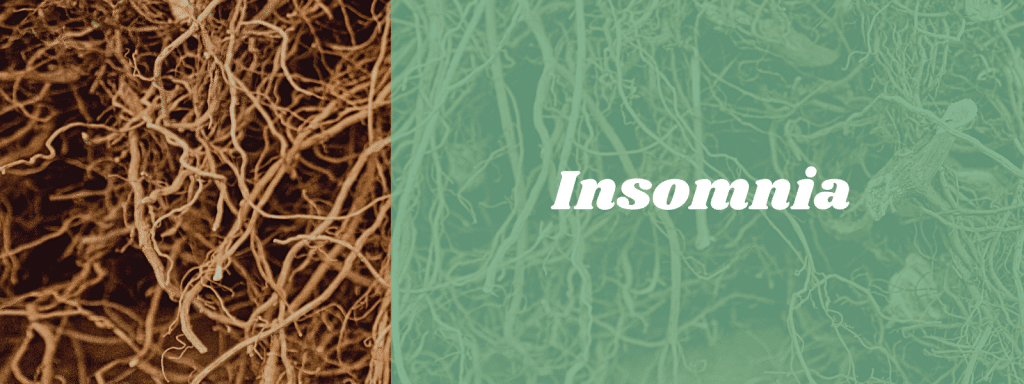
Kava for Insomnia
One study followed 24 men and women who were struggling with stress-induced insomnia. The test evaluated the effects of kava, valerian, and then a combination of the two for treating insomnia.
During the treatment with kava, patients showed a significant stress reduction. There was not much further improvement when the valerian root was introduced, although there was some. The majority of participants didn’t experience any side effects.
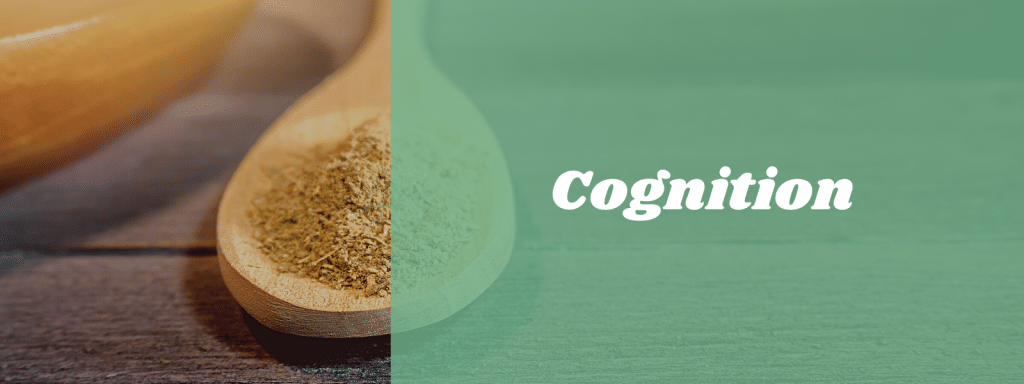
Kava for Cognition (Especially in Comparison to Pharmaceutical Anxiolytics)
One of the significant drawbacks of pharmaceutical anti-anxiety drugs is their impact on cognition. Benzodiazepines, the most commonly-prescribed pharmaceuticals, tend to have a reasonably drastic impact on individual cognition.
On the light end, they may cause mild brain fog or forgetfulness. Heavier benzodiazepines can cause full-on amnesic episodes (blackouts), slurred speech, impaired thinking, lost inhibitions, and unresponsiveness.
Neuroprotection
Kava causes none of these side effects and may actually improve cognition in several ways [22]. Its selective action in the limbic system could be partially responsible for its ability to help enhance anxiety and reduce stress without causing extreme sedation.
Other compounds within the plant show neuroprotective benefits. They have been shown in animal studies to help counteract induced cerebral deficits through several different mechanisms, such as stimulating calcium channels, inhibiting sodium channels and monoamine oxidase, and slowing noradrenaline uptake.
Brainwave Entrainment for Stress Reduction
One study showed that kawain, one of the kavalactones found in the plant, was independently capable of shifting brain waves towards lower frequencies. This dose-dependent shift guided the brain towards increasing states of calmness and relaxation, as evidenced by the expression of the delta, theta, and alpha waves in greater numbers [23].
Memory & Mood
Another study compared the effects of kava and oxazepam, a popular sedative anxiolytic [24]. The goal was to compare the two substances’ effects on memory. All 12 healthy participants showed an increased ability to recognize and recall visuals and words when using kava compared to oxazepam, which led to a statistically significant reduction in memory.
Another study aimed to assess kava’s effects on emotional reactivity and cognition [21]. The patient’s mood was evaluated, and cognitive abilities were observed with the state-trait-cheerfulness-inventory and Sperling partial report and item recognition task, respectively.

The study revealed that just one 300 milligram dose of a standardized extract of kava containing 3% kavalactones (which is a lot, one should mention) led to a significant improvement in cheerfulness. Cheerfulness was noted to be amplified even more in patients who were already predisposed to being cheerful.
Kava also increased accuracy and speed when patients performed report and recognition tasks.
Visual attention and short-term memory were notably improved, which stands in contrast to therapy involving benzodiazepines and other sedative-hypnotic anxiolytics. The typical expectation with these therapies is that most markers for cognitive ability decline during and shortly after treatment.
Safety & Precautions
Liver Effects
Unfortunately, there have been numerous cases of adverse hepatotoxic effects associated with kava, although the frequency of these effects is unknown [25]. While kava is known to cause some mild side effects, such as headaches, drowsiness, diarrhea, and sometimes skin conditions, hepatotoxicity doesn’t seem to be common.
Long-term and heavy use of kava can lead to an increase in glutamyltransferase. This, as well as the potential saturation of the cytochrome P450 pathway through, which numerous drugs and biological agents are processed, may contribute to hepatotoxicity.

There have been 60 severe cases of kava-related liver damage reported by the Medicines Control Agency. Of these cases, 58 involved either concomitant medication or patients who already struggled with liver problems.
Comorbidities
Kava’s MAOI activity means it should also be avoided by people with Parkinson’s, a condition caused in part by excess amounts of dopamine (MAOI prevents the breakdown of dopamine even further).
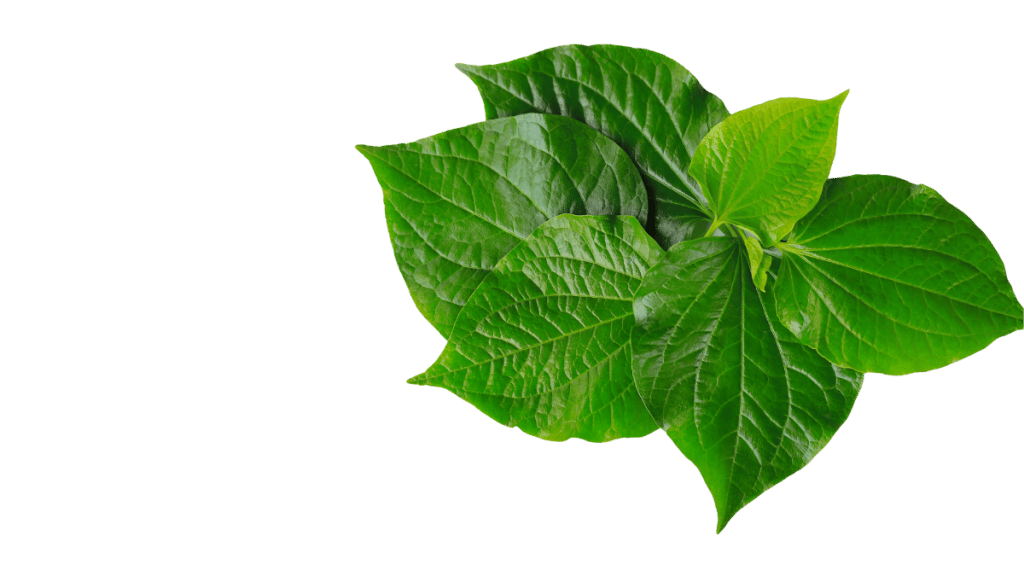
Because of kava’s possible hepatotoxic effects, people with liver and kidney problems should avoid using kava. This is especially true over the long term. Prolonged or excessive use can cause symptoms of jaundice, such as yellowing of the skin, hair, and nails. Short-term usage at recommended dosages is generally regarded as safe.
Kava should also not be given to developing children or used by pregnant or breastfeeding mothers.
If you’re using kava regularly, you should stop taking it at least 24 hours before surgery.
Kava Dermopathy
Long-term and heavy use of kava is known to cause a condition referred to as kava dermopathy. This condition involves an increase in skin pigment. The condition is reversible; simply reduce kava consumption.
Interactions
Kava may interact negatively with other herbs or drugs that share similar actions.
Speak with your doctor if you’re considering using kava with another medication due to its effect as an MAOI. It can severely potentiate other drugs.
Do not mix kava with other GABAergic drugs, including benzodiazepines, alcohol, and most sleeping pills. It may dangerously increase the sedative effect of certain other drugs.

Kavalactones are known for their potent inhibition of the CYP450 cytochrome enzyme. This enzyme metabolizes and breaks down numerous drugs; consuming kava alongside these drugs will increase their potency and duration.
Common drugs metabolized by CYP450 include antiplatelet drugs, diuretics, and numerous other drugs that may be hepatotoxic.
Conclusion: Kava for Health
Kava kava is a popular beverage that people of the Pacific Islands have enjoyed for centuries. Since the arrival of European settlers and the subsequent export of kava worldwide, it has become globally recognized as an effective social lubricant and anxiolytic.
Kava is generally regarded as safe. The only side effect recognized as being directly caused by heavy kava consumption is a reversible form of dermopathy that results in increased skin pigmentation. However, kava can interact with a fairly diverse number of drugs and herbs as an MAOI and an inhibitor of CYP450.
Regardless, most people should be able to enjoy kava with the proper respect and precautions. Properly prepared, kava can provide a short buzz that reduces stress, lowers inhibitions, improves mood, and enhances cognition.
- Mgbeahuruike, Eunice Ego, et al. “Bioactive compounds from medicinal plants: Focus on Piper species.” South African Journal of Botany 112 (2017): 54-69.
- Apo’Aporosa, S., Ballard, H., Pandey, R., & McCarthy, M. J. (2022). The impact of traditional kava (Piper methysticum) use on cognition: Implications for driver fitness. Journal of ethnopharmacology, 291, 115080.
- Lebot, V., Merlin, M., & Lindstrom, L. (1997). Kava: The Pacific elixir: The definitive guide to its ethnobotany, history, and chemistry. Inner Traditions/Bear & Co.
- Kuchta, K., Schmidt, M., & Nahrstedt, A. (2015). German kava ban lifted by court: The alleged hepatotoxicity of kava (Piper methysticum) as a case of ill-defined herbal drug identity, lacking quality control, and misguided regulatory politics. Planta medica, 81(18), 1647-1653
- Aust N Z J Psychiatry. 2011;45(1):27–35. Kava: a comprehensive review of efficacy, safety, and psychopharmacology. Sarris J, et al..
- Lebot, V., & Lévesque, J. (1989). The origin and distribution of kava (Piper methysticum Forst. f., Piperaceae): A phytochemical approach. Allertonia, 223-281.
- Ooi, S. L., Henderson, P., & Pak, S. C. (2018). Kava for generalized anxiety disorder: a review of current evidence. The Journal of Alternative and Complementary Medicine, 24(8), 770-780.
- Izawa, T., & Mukaiyama, T. (1975). A CONVENIENT METHOD FOR THE PREPARATION OF δ-HYDROXY-β-KETOESTERS AND 6-ALKYL-5, 6-DIHYDRO-4-HYDROXY-2-PYRONES. APPLICATION TO THE SYNTHESES OF KAWAIN AND DIHYDROKAWAIN. Chemistry Letters, 4(2), 161-164.
- Davies, L. P., Drew, C. A., Duffield, P., Johnston, G. A., & Jamieson, D. D. (1992). Kava pyrones and resin: studies on GABAA, GABAB and benzodiazepine binding sites in rodent brain. Pharmacology & toxicology, 71(2), 120-126.
- ACTIVES, I. O. (1998). Kava: A South Pacific Herb for Anxiety, Tension, and Insomnia
- Singh, Y. N., & Singh, N. N. (2002). Therapeutic potential of kava in the treatment of anxiety disorders. CNS drugs, 16(11), 731-743.
- Ligresti, A., Villano, R., Allarà, M., Ujváry, I., & Di Marzo, V. (2012). Kavalactones and the endocannabinoid system: the plant-derived yangonin is a novel CB1 receptor ligand. Pharmacological Research, 66(2), 163-169.
- Singh, Y. N. (2005). Potential for interaction of kava and St. John’s wort with drugs. Journal of ethnopharmacology, 100(1-2), 108-113.
- Feltenstein, M. W., Lambdin, L. C., Ganzera, M., Ranjith, H., Dharmaratne, W., Nanayakkara, N. D., … & Sufka, K. J. (2003). Anxiolytic properties of piper methysticum extract samples and fractions in the chick social–separation–stress procedure. Phytotherapy Research, 17(3), 210-216.
- Mathias, R. (2001). Even Modest Cocaine Use May Cause Brain Changes That Could Contribute to Addiction. NIDA Notes, 16(3).
- Pittler, M. H., & Ernst, E. (2003). Kava extract versus placebo for treating anxiety. Cochrane Database of Systematic Reviews, (1).
- Volz, H. P., & Kieser, M. (1997). Kava-kava extract WS 1490 versus placebo in anxiety disorders-a randomized placebo-controlled 25-week outpatient trial. Pharmacopsychiatry, 30(01), 1-5.
- Cagnacci, A., Arangino, S., Renzi, A., Zanni, A. L., Malmusi, S., & Volpe, A. (2003). Kava–Kava administration reduces anxiety in perimenopausal women. Maturitas, 44(2), 103-109.
- Singh, Y. N. (2004). An introduction to kava Piper methysticum. Kava: From Ethnology to Pharmacology (Medicinal and Aromatic Plants-Industrial Profiles Volume 37), 1-9.
- Cagnacci, A., Arangino, S., Renzi, A., Zanni, A. L., Malmusi, S., & Volpe, A. (2003). Kava–Kava administration reduces anxiety in perimenopausal women. Maturitas, 44(2), 103-109.
- Thompson, R., Ruch, W., & Hasenöhrl, R. U. (2004). Enhanced cognitive performance and cheerful mood by standardized extracts of Piper methysticum (Kava‐kava). Human Psychopharmacology: Clinical and Experimental, 19(4), 243-250.
- Stevinson, C., Huntley, A., & Ernst, E. (2002). A systematic review of the safety of kava extract in the treatment of anxiety. Drug Safety, 25(4), 251-261.

